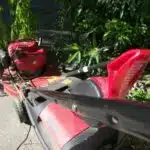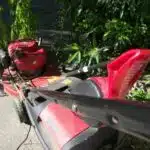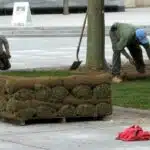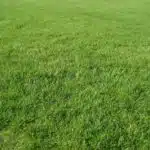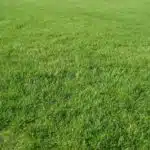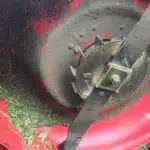Proper lawn care is essential to maintaining a healthy and beautiful lawn. Aeration is an important aspect of lawn care that should not be overlooked. It involves creating small holes in the soil to allow air, water, and nutrients to penetrate deeper into the roots of the grass. This process helps to relieve soil compaction, improves drainage, and enhances root growth. In this article, we will discuss when and how you should aerate your lawn to ensure optimal results.
Aeration is best done during the growing season when the grass is actively growing. For cool-season grasses like fescue and Kentucky bluegrass, this would be in the spring or fall when temperatures are cooler. Warm-season grasses like Bermuda and zoysia should be aerated in late spring or early summer when they are actively growing. The frequency of aeration depends on various factors such as soil type, foot traffic, and weather conditions. A heavily compacted lawn may require aeration twice a year while a less compacted one may need it only once every few years. In the next section, we will discuss different methods of aeration and which one might be best for your specific lawn needs.
The Importance Of Aeration In Lawn Care
As a lawn care and aeration expert, I cannot stress enough the importance of regular aeration in maintaining a healthy and lush lawn. Aeration is the process of creating small holes in the soil to allow air, water, and nutrients to penetrate deeper into the roots of your grass. This process helps create an environment that promotes healthy growth and helps prevent soil compaction.
One of the benefits of aeration is that it improves soil drainage. When your lawn becomes compacted, water struggles to penetrate deeper into the soil, leading to runoff and wastage. Aeration alleviates this problem by allowing water to reach deeper into the roots, promoting better absorption and reducing the likelihood of overwatering. Additionally, as water penetrates deeper into the soil, it carries vital nutrients with it which are essential for plant growth.
Aeration also plays an important role in overseeding. When you overseed your lawn without first aerating it, new seed may struggle to establish because it cannot reach deep enough into the soil. By aerating before overseeding, you create channels for new seed to penetrate deeper into the ground where it can take root more effectively. Overall, regular aeration is an essential part of any comprehensive lawn care program that aims to promote healthy growth and prevent common issues such as soil compaction. Understanding soil compaction is crucial if you want your lawn to remain healthy year-round.
Understanding Soil Compaction
Soil compaction is a common problem that affects the health and appearance of your lawn. This occurs when the soil becomes too dense and compacted, making it difficult for air, water, and nutrients to reach the roots of your grass. The primary cause of soil compaction is foot traffic, but heavy machinery, improper watering techniques, and poor soil quality can also contribute to this problem.
One effective way to identify soil compaction is through soil testing. By taking a sample of your soil and analyzing its texture, composition, and nutrient content, you can determine if it is compacted and in need of aeration. Another sign of soil compaction is the presence of puddles or standing water after rainfall. This indicates that water is not able to penetrate the soil properly due to its density.
To prevent or alleviate soil compaction on your lawn, consider implementing proper watering techniques such as deep watering infrequently rather than frequent shallow watering. You should also avoid walking or driving on your lawn frequently and aerate it regularly using core aeration equipment. This process involves removing small plugs of soil from the ground to create small holes that allow air, water, and nutrients to penetrate the root zone easily.
In summary, understanding soil compaction is crucial for maintaining healthy grass on your lawn. By using proper watering techniques and regularly aerating your lawn with core aeration equipment, you can prevent or alleviate this problem effectively. In the next section we will discuss signs that indicate your lawn needs aeration so that you can take proactive steps towards keeping your lawn lush and green all year round!
Signs That Your Lawn Needs Aeration
Understanding soil compaction is crucial in maintaining a healthy lawn. Compacted soil can hinder the growth of roots and make it difficult for water, nutrients, and air to penetrate through the soil. Signs that your lawn needs aeration include thinning turf, excessive thatch buildup, and pooling water after rain or irrigation.
Now that you know the importance of aerating your lawn let’s dive into the benefits of aeration. First, it allows air, water, and nutrients to penetrate deeper into the soil promoting root growth. Second, it breaks up compacted soil allowing roots to spread out more easily. Third, it increases microbial activity in the soil which promotes decomposition of organic matter.
Common lawn issues such as heavy traffic or clay soils can lead to soil compaction which requires aeration. It is recommended to aerate cool-season grasses such as Kentucky bluegrass or fescue in early spring or fall when they are actively growing. Warm-season grasses like Bermuda or Zoysia should be aerated during their peak growing season in late spring or early summer.
- Aerate lawns every one to three years depending on soil conditions.
- Choose the right type of aerator for your lawn size and type.
- Remove any debris such as rocks or sticks from your lawn before aerating.
Knowing when and how to properly aerate your lawn will help maintain a healthy and lush turf for years to come.
When To Aerate Cool-Season Grasses
Aerating cool-season grasses is recommended to be done in the spring or fall, when the soil is moist and temperatures are cooler. For optimal results, aeration should be performed when the grass is actively growing, usually in the late spring or early fall. To ensure adequate time to recover from the aeration process, it is important to aerate before the onset of extreme temperatures. It is also important to aerate before a heavy fertilizer application and before overseeding for best results.
Timing
As a lawn care and aeration expert, I understand the importance of timing when it comes to aerating cool-season grasses. Best practices dictate that the optimal time to aerate your lawn is during the growing season in early spring or fall. During these times, the grass is actively growing and can quickly recover from any damage caused by aeration. Additionally, cooler temperatures and increased moisture levels in the soil during fall ensure better results.
One of the most common mistakes people make is aerating their lawns during summer when the weather is hot and dry. This is not recommended as it can cause additional stress on already struggling grass roots, leading to further damage. Similarly, aerating too late in fall can result in insufficient recovery time for the grass before winter sets in.
In conclusion, as an expert in lawn care and aeration, I recommend following best practices for timing when it comes to aerating cool-season grasses. Aerating during early spring or fall will ensure that your lawn stays healthy and vibrant throughout the year. Avoiding common mistakes such as aerating during summer or too late in fall will help you achieve optimal results for your lawn.
Seasonality
As a lawn care and aeration expert, I understand that seasonal changes can significantly affect the health of your lawn. Therefore, it is crucial to consider seasonality when determining the best time to aerate cool-season grasses. Best practices for seasonal lawn aeration dictate that early spring or fall is the optimal time for aeration. However, there are several factors affecting timing that must be taken into account.
One factor to consider is the soil moisture level. It is essential to aerate when the soil is moist but not saturated. A dry and compacted soil may require watering before aeration to ensure optimal results. Another factor is the type of grass in your lawn. Cool-season grasses such as Kentucky Bluegrass, Fescue, and Ryegrass thrive in cooler temperatures and may not withstand extreme heat during summer months.
Lastly, it’s worth considering any recent treatments or fertilizations on your lawn before scheduling an aeration session. Aerating too soon after these treatments may cause further damage to already weakened roots. As an expert in lawn care and aeration, I recommend consulting with your local professional before proceeding with any activities on your lawn.
In conclusion, understanding seasonality is vital when determining the best time for aerating cool-season grasses. Factors such as soil moisture levels, grass type, and recent treatments should be considered before scheduling an aeration session. By following best practices for seasonal lawn aeration and seeking advice from professionals, you can ensure that your lawn stays healthy and vibrant throughout the year.
When To Aerate Warm-Season Grasses
Aeration is a crucial lawn care practice that involves perforating the soil with small holes to allow air, water, and nutrients to penetrate the roots of grass. This process can provide several benefits for your lawn, including improved soil structure, enhanced root development, and increased resistance to drought and disease. However, it is important to know when to aerate your warm-season grasses to ensure optimal results.
The best time to aerate warm-season grasses is during their active growth period when they are actively producing new roots and shoots. In most regions of the United States, this occurs during the late spring or early summer months. Aerating at this time can help stimulate root growth and increase nutrient uptake, resulting in a healthier and more resilient lawn.
To determine if your lawn needs aeration, you can perform a simple test by pushing a screwdriver into the soil. If it goes in easily, then your soil is probably not compacted enough for aeration. However, if it takes significant effort to penetrate the soil or if you notice excessive thatch buildup on top of the turfgrass layer, then it may be time for an aeration treatment.
| Lawn Characteristics | Frequency of Aeration |
|---|---|
| Sandy Soil | Once per year |
| Heavy Clay Soil | Twice per year |
| High Traffic Areas | Twice per year |
| Lawns with Thatch Buildup | Once per year |
In summary, knowing when to aerate your warm-season grasses can help you achieve a lush and healthy lawn with minimal effort. By timing your aeration treatment during their active growth period and evaluating the need for treatment based on soil compaction and thatch buildup, you can improve nutrient uptake and root development while preventing common lawn problems such as disease and drought stress. In the next section, we will discuss how frequently you should aerate your lawn based on its unique characteristics.
Frequency Of Aeration Based On Lawn Characteristics
Aeration is an important part of lawn care that should be done at least once a year, depending on the lawn’s characteristics. For low-traffic lawns, aeration can be done either in the spring or in the fall, while higher-traffic lawns may require more frequent aeration during the growing season. Aeration helps to reduce compaction, improve drainage, and improve the overall health of the lawn. Additionally, a high-traffic lawn may benefit from more frequent aeration during the growing season to help with soil and root development.
Aeration Frequency For Low-Traffic Lawns
As a lawn care and aeration expert, one of the most frequent questions I get asked is how often low-traffic lawns should be aerated. Aeration frequency for low-traffic lawns will depend on factors such as soil type, grass type, and weather conditions. However, as a general rule of thumb, it is recommended to aerate once every 1-3 years.
The benefits of regular aeration on soil health cannot be overstated. Aeration helps relieve soil compaction by creating small holes in the ground that allow water, air, and nutrients to penetrate deep into the soil. This process also encourages root growth and improves overall turf density. As such, it is essential to assess your lawn’s condition before deciding on an aeration schedule.
It is worth noting that high-traffic lawns will require more frequent aeration than low-traffic ones due to the added stress caused by foot traffic. If you have children or pets who frequently play on your lawn or if you regularly host outdoor events, consider aerating every year or even twice per year. By doing so, you are ensuring that your lawn stays healthy and lush throughout the year.
Aeration Frequency For High-Traffic Lawns
When it comes to maintaining a healthy and lush lawn, aeration is an essential practice that should not be overlooked. As discussed in the previous subtopic, low-traffic lawns require less frequent aeration compared to high-traffic ones due to the added stress caused by foot traffic. High-traffic lawns include those found in sports fields, parks, and other public places where people frequently gather.
The benefits of aeration on soil health have been well-established. By creating small holes in the ground, water, air, and nutrients can penetrate deep into the soil, promoting root growth and improving overall turf density. For high-traffic lawns such as sports fields, regular aeration is necessary to maintain the field’s playing surface quality and prevent injuries caused by uneven terrain.
Aeration timing for sports fields will depend on several factors such as grass type, weather conditions, and frequency of use. However, as a general rule of thumb, it is recommended to aerate at least twice per year for high-traffic areas or before and after each season. By doing so, you are ensuring that your field stays healthy and safe for athletes to use.
Different Methods Of Aeration
There are various ways to aerate a lawn, each with different benefits and drawbacks. One method is using an aeration machine, which is a tool that removes small plugs of soil from the ground. The process involves rolling the machine over the lawn, and it can be done by hiring a professional or renting equipment for DIY aeration. Aeration machines are ideal for large lawns as they cover more ground in less time compared to other methods.
Another method of lawn aeration is called spike aeration. This technique involves poking holes into the soil with spikes on shoes or rollers. Spike aeration is not as effective as plug removal because it does not create space for air, water, and nutrients to penetrate deep into the soil. However, it’s still useful for loosening up compacted soil and relieving surface tension.
Liquid aerators are also available but considered less effective than mechanical methods. They work by breaking down clay and other compacted soils chemically. Liquid aerators may take several applications before seeing results but are an inexpensive option compared to other methods.
- Topdressing: This process involves applying organic matter such as compost on top of the grass after removing thatch build-up on topsoil layer.
- Mulching: Mulching involves applying finely cut organic matter such as grass clippings or leaves over the lawn surface.
In conclusion, there are several ways to aerate your lawn depending on your budget and time constraints. Aerating machines provide quick results but may come at higher costs while liquid aerators are affordable but take longer to yield results. Spike aeration can be done quickly and cheaply but doesn’t penetrate deep enough into the soil. Incorporating topdressing or mulching can improve soil health in combination with any of the above techniques. Up next, manual aeration with a garden fork provides an alternative DIY method for those willing to put in some elbow grease.
Manual Aeration With A Garden Fork
Manual aeration with a garden fork is a cost-effective and simple way to improve the health of your lawn. The process involves using a garden fork to create holes in the soil, allowing air, water, and nutrients to penetrate deeper into the root zone. This technique is particularly useful for lawns with compacted soil or those that have not been aerated in some time.
Benefits of manual aeration include improving soil structure, reducing water runoff, enhancing nutrient uptake, and promoting healthier grass growth. By creating space for air and water to circulate freely in the soil, manual aeration also helps to reduce the incidence of thatch buildup, which can be detrimental to grass growth. In addition, it allows fertilizer and other treatments to reach the root zone more efficiently.
Tips for effective manual aeration include choosing the right time of year, selecting the appropriate tools, and paying attention to spacing between holes. For cool-season grasses such as Kentucky bluegrass and fescue, early spring or fall are optimal times for manual aeration. Warm-season grasses like Bermuda grass should be aerated in late spring or summer. Using a garden fork with long tines will make it easier to penetrate compacted soil. Aim for hole spacing of approximately 3-4 inches apart.
In summary, manual aeration with a garden fork is an effective method for improving lawn health without breaking the bank. By following these tips and incorporating this technique into your regular lawn care routine, you can enjoy all of the benefits that improved soil structure provides. In our next section about core aeration with a machine we will explore another popular method for aerating lawns that involves equipment rather than manual labor.
Core Aeration With A Machine
Core aeration with a machine is a highly recommended lawn maintenance procedure that involves the removal of small cores of soil from the lawn. This process is done by using a specialized machine known as an aerator, which extracts 2-3 inch plugs of soil and deposits them on the surface of the lawn. Core aeration should be carried out at least once every year, preferably during the growing season when the grass is actively growing.
The benefits of core aeration are numerous. One important benefit is that it relieves soil compaction, which allows air, water, and nutrients to penetrate deeper into the soil. This results in healthier roots, stronger grass plants, and increased resistance to drought stress. Additionally, core aeration increases microbial activity in the soil, leading to better breakdown of thatch and improved nutrient cycling. Finally, core aeration also improves seed germination rates by providing more space for new seedlings to grow.
The cost of renting or buying a core aerator can vary depending on where you live and what type of machine you need. However, most rental companies charge between $50-$100 per day for a walk-behind aerator while larger machines can range from $150-$400 per day. Although this may seem expensive initially, it is important to consider that core aeration is an investment in your lawn’s long-term health and beauty. Ultimately, hiring a professional lawn care service to perform core aeration may be more cost-effective than renting or purchasing your own machine if you do not have experience with this process.
Transition: While core aeration machines are highly effective for relieving soil compaction and promoting healthy turf growth, they may not always be necessary or feasible for some homeowners. If you’re looking for an alternative method for aerating your lawn without investing in expensive machinery or equipment rentals, spike aeration with shoes or tools can be an accessible solution worth exploring further.
Spike Aeration With Shoes Or Tools
As the famous adage goes, “the grass is always greener on the other side”. But what if we tell you that you can make your own yard greener by aerating it properly? One effective way of doing so is through spike aeration. This process involves puncturing small holes in your lawn using spikes, either with the use of special shoes or tools.
Spike aeration has both its pros and cons. The main advantage of this method is that it’s relatively cheaper compared to other forms of aeration. It’s also very easy to do, even for beginners. However, one potential downside is that it may not be as effective as other types of aeration such as core aeration. Spike aeration only creates small holes which can easily close up again, limiting the amount of air and nutrients that can penetrate deeper into the soil.
If you’re considering spike aeration for your lawn, choosing the right shoes or tools to use is crucial. For shoes, make sure that they have sturdy spikes that are long enough to pierce through the soil but not too long that they damage your lawn roots. Shoes with adjustable straps are also recommended for better fit and comfort during the process. As for tools, handheld devices with sharp spikes are ideal for smaller lawns while larger lawns may require motorized versions for faster and more efficient work.
Now that you know about spike aeration, it’s time to explore another type of aeration: liquid aeration with soil conditioners. This method involves applying liquid solutions to your lawn which helps loosen compact soil and improve overall soil health. Stay tuned for our next section where we’ll discuss this process in detail!
Liquid Aeration With Soil Conditioners
Spike aeration with shoes or tools can be effective in relieving soil compaction and promoting better nutrient uptake for your lawn. However, if you are looking for a more efficient and less labor-intensive method, liquid aeration with soil conditioners may be worth considering. This technique involves spraying a liquid solution containing natural enzymes, humic acid, and other organic compounds that help break down compacted soil.
One of the benefits of using a soil conditioner is that it improves the overall health of your lawn. The enzymes and organic matter in the solution stimulate microbial activity in the soil, which helps to break down thatch and improve nutrient availability. Humic acid also helps to improve water retention in the soil, reducing runoff and ensuring that your lawn stays hydrated during periods of drought.
When it comes to effectiveness, liquid aeration has been shown to provide better results than spike or plug aerators. This is because the liquid solution can penetrate deeper into the soil, reaching areas that hand tools or machines cannot access. Additionally, liquid aeration does not cause any damage to your lawn’s surface like spike aerators can do when they puncture the grass blades or roots.
In order to choose the best aeration method for your lawn, consider factors such as its size, type of grass, level of compaction, and budget. While spike aeration may be suitable for smaller lawns with light compaction levels or tight budgets, larger lawns with heavy clay soils may benefit more from liquid aeration with soil conditioners. Ultimately, consulting with a lawn care professional can help you make an informed decision based on the specific needs of your lawn.
Choosing The Best Aeration Method For Your Lawn
When it comes to aerating your lawn, choosing the right method can make all the difference. There are several different options available, each with their own benefits and drawbacks. By understanding the pros and cons of each method, you can choose the one that is best suited to your needs.
One option is mechanical aeration. This involves using a machine to punch holes in your soil, allowing air, water, and nutrients to penetrate deeper into the ground. While this is one of the most effective methods available, it can be expensive and may require professional assistance. It’s also important to note that mechanical aeration should only be done when your lawn actually needs it – over-aerating can damage your grass and leave it vulnerable to pests and diseases.
Another option is liquid aeration. This involves applying a special mixture of ingredients to your lawn that will help loosen compacted soil and promote better drainage. While this method is typically less expensive than mechanical aeration, it may not be as effective on severely compacted soil. Additionally, liquid aeration products are not always created equal – some are more effective than others.
If you’re looking for a DIY solution, there are several options available as well. One popular choice is spike aerators, which involve pushing spikes into your soil with either shoes or a handheld tool. While this method can be effective in some cases, it tends to be less thorough than other methods and may not provide enough benefit for severely compacted soil. Another DIY option is core aerators – these machines remove small plugs of soil from your lawn instead of simply punching holes in it. However, core aerators can be difficult to operate properly without professional assistance.
Overall, choosing the best aeration method for your lawn will depend on several factors – including how compacted your soil is and what your budget looks like. Before you get started with any type of aeration project, it’s important to have your soil tested to determine its pH level and nutrient content. This will help you choose the right method and ensure that your lawn gets the full benefit of aeration. In the next section, we’ll take a look at how to prepare your lawn for aeration so that you can get the best possible results.
Preparing Your Lawn For Aeration
After choosing the best aeration method for your lawn, it’s time to prepare for the actual aeration process. One important step in preparing your lawn for aeration is dethatching. Dethatching refers to removing the layer of dead grass and other debris that accumulates on the surface of your lawn over time. This layer can prevent water, nutrients, and air from reaching the roots of your grass, making it more difficult for your lawn to thrive. By removing this layer before aerating your lawn, you can ensure that the aerator penetrates deeply into the soil and reaches the roots.
Another way to prepare your lawn for aeration is by using compost. Compost is made up of decomposed organic matter and is an excellent source of nutrients for your grass. Using compost before aerating can help improve soil quality and provide essential nutrients that will help your grass grow strong and healthy. Additionally, adding compost to your lawn can help improve drainage and reduce soil compaction, allowing better access to air and water.
Overall, preparing your lawn properly before aeration can make all the difference in achieving a healthy and thriving lawn. By dethatching and using compost, you’ll be setting yourself up for success when it comes to post-aeration care. In our next section, we’ll discuss some important tips for caring for your lawn after aeration so that you can continue to enjoy a beautiful, lush landscape year-round.
Post-Aeration Lawn Care Tips
- After aerating a lawn, watering it lightly is important to ensure that the soil does not become too dry.
- Fertilizing the lawn after aeration is also beneficial, as it encourages healthy turf growth.
- During the first few weeks following aeration, mowing should be done more often to ensure that the lawn is kept short and even.
- When mowing, it is important to avoid cutting off more than 1/3 of the grass blades at any given time.
- After the lawn is re-established, mowing can be done on a normal schedule.
- Finally, it is important to remember that aeration should be done regularly to ensure that the lawn remains healthy and vibrant.
Watering
Proper watering techniques are crucial for maintaining a healthy and vibrant lawn after aeration. The first step in post-aeration lawn care is to ensure that the soil remains moist, but not overly saturated. One effective way to achieve this is by using a lawn irrigation system, which provides consistent and even watering throughout the yard.
When using a lawn irrigation system, it’s important to adjust the settings based on weather conditions and the specific needs of your lawn. During hot and dry periods, you may need to water more frequently or for longer periods of time to prevent the soil from drying out. On the other hand, during cooler months or when there is ample rainfall, you can reduce watering frequency to avoid overwatering.
In addition to utilizing an irrigation system, homeowners can also benefit from hand-watering areas that are difficult for sprinklers to reach or where additional moisture is needed. By following these watering techniques, homeowners can ensure that their lawns remain healthy and beautiful long after aeration has been completed.
Fertilizing
As a lawn care and aeration expert, I highly recommend homeowners to follow the best practices for post-aeration lawn care. Apart from proper watering techniques, fertilizing is another essential aspect of maintaining a healthy and vibrant lawn. Fertilizing helps provide the necessary nutrients for grass roots to grow deeper and stronger, resulting in thicker and greener turf.
The best time to fertilize your lawn after aeration is within the first two weeks. This period allows for maximum nutrient absorption by the roots. However, it’s crucial to avoid common mistakes such as over-fertilizing or using the wrong type of fertilizer. Over-fertilization can lead to burnt patches on your lawn, while using the wrong fertilizer can result in stunted growth or even death of your grass.
To ensure that you’re using the right fertilizer for your lawn, it’s best to consult with a professional or read product labels carefully. Additionally, consider using organic fertilizers that are eco-friendly and promote long-term soil health. By following these best practices and avoiding common mistakes, homeowners can achieve a lush, green lawn that will be the envy of their neighborhood.
Mowing
Proper mowing is an essential aspect of post-aeration lawn care. After aeration, it’s crucial to adjust your mowing practices to avoid damaging the newly-growing roots. The first thing you should consider is the height of your mower blade. It’s best to raise your blade higher during the first few weeks after aeration to allow for proper root development. Cutting the grass too short can stress the grass and slow down its recovery.
Mowing frequency is another important consideration when it comes to post-aeration lawn care. It’s best to avoid excessive mowing within the first two weeks after aeration to allow for maximum nutrient absorption by the roots. Additionally, avoid mowing wet grass as this can cause clumping and uneven cuts that can damage your lawn. Instead, wait until the grass has dried off before mowing.
In conclusion, proper mowing techniques are crucial for maintaining a healthy and vibrant lawn after aeration. By adjusting your mower blade height and avoiding excessive mowing frequency, you’ll help ensure that your grass roots grow deeper and stronger while avoiding damage to new growth. With these tips in mind, homeowners can achieve a lush, green lawn that will be the envy of their neighborhood.
Evaluating The Results Of Aeration On Your Lawn
Like a surgeon examining the results of a procedure, evaluating the effectiveness of lawn aeration is crucial for achieving a healthy and lush lawn. Aeration is an important step in maintaining your lawn’s health, but how do you know if it’s working? Comparing the results of aeration with other lawn treatments can help determine if this method is the best choice for your specific needs.
One way to evaluate the effectiveness of aeration is by observing the growth of new grass after treatment. If you notice thicker, healthier grass growing in areas where it was sparse before, then aeration has been successful. Another way to gauge its effectiveness is by looking at water retention in your soil. After aerating, water should be able to penetrate deeper into the soil and stay there longer. This allows roots to grow deeper and access more nutrients from the soil.
Comparing aeration with other lawn treatments can also help determine its effectiveness. For example, applying fertilizers and pesticides may improve the overall appearance of your lawn, but they don’t address underlying problems such as soil compaction. Aeration helps alleviate these issues by promoting air circulation and reducing compaction. By comparing these methods, you can determine which treatment will provide long-term benefits for your lawn.
In conclusion, evaluating the effectiveness of lawn aeration is essential for maintaining a healthy and vibrant yard. Observing new growth and improved water retention are two ways to gauge its success, while comparing it with other treatments will help determine if it’s right for you. With proper evaluation and maintenance, aerating your lawn can lead to long-lasting benefits that will keep your yard looking great year-round.
Conclusion
In conclusion, aeration is an essential aspect of lawn care that helps to promote healthy grass growth and improved soil health. By understanding the importance of soil compaction and the signs that indicate a need for aeration, homeowners can choose the best time to aerate their lawns. It is recommended that cool-season grasses be aerated in early spring or fall while warm-season grasses require late spring to summer aeration.
Choosing the best aeration method for your lawn, preparing it for aeration, and following post-aeration care tips are equally important factors to ensure maximum results. Homeowners should evaluate the results of aeration on their lawn regularly to determine if additional treatments are necessary. Properly aerating your lawn can prevent soil compaction, improve root development and water infiltration leading to stronger and healthier turf growth throughout the year.
Image Credits
- “Manual aeration of the lawn” by Vincent Ma (featured)




